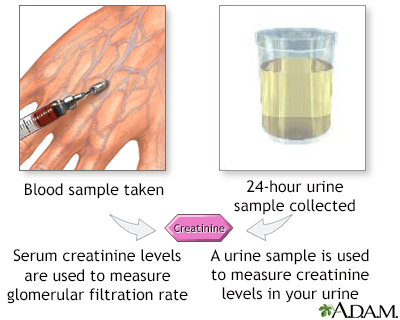Creatinine clearance test
Definition
The creatinine clearance test helps provide information about how well the kidneys are working. The test compares the creatinine level in urine with the creatinine level in blood.
Alternative Names
Serum creatinine clearance; Kidney function - creatinine clearance; Renal function - creatinine clearance
How the Test is Performed
This test requires both a urine sample and blood sample. You will collect your urine for 24 hours and then have blood taken. Follow instructions exactly. This ensures accurate results.
How to Prepare for the Test
Before the test, your health care provider may ask you to stop taking medicines that may affect the test results. These include some antibiotics and stomach acid medicines. Be sure to tell your provider about all the medicines you take.
DO NOT stop taking any medicine before talking to your provider.
How the Test will Feel
The urine test involves only normal urination. There is no discomfort.
When the needle is inserted to draw blood, some people feel moderate pain. Others feel only a prick or stinging. Afterward, there may be some throbbing or a slight bruise. This soon goes away.
Why the Test is Performed
Creatinine is a waste product of creatine. Creatine is a chemical the body makes to supply energy, mainly to muscles.
The creatinine clearance test compares the creatinine level in urine with the creatinine level in blood. This gives an estimate of the glomerular filtration rate (GFR). GFR is a measure of how well the kidneys are working, mainly the kidneys' filtering units. These filtering units are called glomeruli.
Creatinine is removed, or cleared, from the body by the kidneys. If kidney function is abnormal, creatinine level increases in the blood because less creatinine is excreted through the urine.
Normal Results
Clearance is often measured as milliliters per minute (mL/min) or milliliters per second (mL/s). Normal values are:
- Male: 97 to 137 mL/min (1.65 to 2.33 mL/s).
- Female: 88 to 128 mL/min (14.96 to 2.18 mL/s).
Normal value ranges may vary slightly among different laboratories. Some labs use different measurements or test different samples. Talk to your doctor to know about the meaning of your specific test results.
What Abnormal Results Mean
Abnormal results (lower than normal creatinine clearance) may indicate:
- Kidney problems, such as damage to the tubule cells
- Kidney failure
- Too little blood flow to the kidneys
- Damage to the filtering units of the kidneys
- Loss of body fluids (dehydration)
- Bladder outlet obstruction
- Heart failure
Risks
There is little risk involved with having your blood taken. Veins and arteries vary in size from one person to another and from one side of the body to the other. Taking blood from some people may be more difficult than from others.
Other risks associated with having blood drawn are slight, but may include:
- Excessive bleeding
- Fainting or feeling lightheaded
- Multiple punctures to locate veins
- Hematoma (blood accumulating under the skin)
- Infection (a slight risk any time the skin is broken)
Gallery

References
Landry DW, Bazari H. Approach to the patient with renal disease. In: Goldman L, Schafer AI, eds. Goldman-Cecil Medicine. 26th ed. Philadelphia, PA: Elsevier; 2020:chap 106.
Oh MS, Briefel G, Pincus MR. Evaluation of renal function, water, electrolytes, and acid-base balance. In: McPherson RA, Pincus MR, eds. Henry's Clinical Diagnosis and Management by Laboratory Methods. 24th ed. Philadelphia, PA: Elsevier; 2022:chap 15.